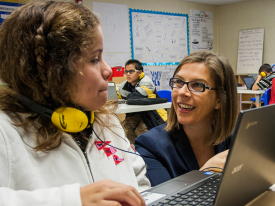Designing Schools that Generate Real Value for Vulnerable Students, Part 1
Topics

Together, educators are doing the reimagining and reinvention work necessary to make true educational equity possible. Student-centered learning advances equity when it values social and emotional growth alongside academic achievement, takes a cultural lens on strengths and competencies, and equips students with the power and skills to address injustice in their schools and communities.
Chris Sturgis of MetisNet walks through the first two of five missteps educators take when designing blended, personalized, proficiency-based schools, with advice for what to do differently.
What is preventing us from seeing more innovation and greater gains?
It’s a question that gnaws at me. The easy answer is that we haven’t taken the cap off our system, allowing students at every grade to advance upon mastery to higher levels. However, that’s not going to increase achievement for low-income and other vulnerable students. We must have some blindspots, assumptions, or practices that are getting in our way. So here is my list of five places we trip up when designing blended, personalized, proficiency-based schools—and what we need to do differently to make sure we generate real value for vulnerable students:
- We are wired for linearity –––––––> Design for gaps and high mobility.
- We innovate from where we are, not where we want to be –––––––> Design for performance and backward plan to basic skills.
- We assume that what we put in place will work –––––––> Design for not yet proficient.
- We act as if we can’t change attitudes and maturity of our student –––––––> Invest in maturation
- We are driven by only one half of the equation –––––––> Get smart about cost-effectiveness.
In today’s post, I’ll tackle the first two issues on my list. Tomorrow, I’ll write about the last three.
1. Gaps and High Mobility
We are wired for linearity: Design for gaps and high mobility.
Many innovative schools design as if the students are going to be at grade level or just a bit behind. I’ve heard several NGLC grantees talk about how surprised they were at the size of the gaps and how they had to quickly patch together more supports for students.
Often we think if we just fix the earlier grades this problem will go away. Sure the problem may get smaller but it isn’t going to go away. Where there is poverty, there is high mobility. Low-income students are going to be changing schools mid-year because their parents found a job, they lost their apartment, or they could find a safer place to live. And with mobility comes gaps. So let’s design for gaps—big ones—in all we do.
In competency-based schools, it’s important to really know your students. It starts with rich assessments when they enter a school or a classroom to understand the levels they are at and the gaps that may trip them up. Then school-wide strategies are used to support gap filling and if needed, accelerating the rate of learning. Learning progressions may stretch several levels (not just one grade or course), preparation time may be offered for students with gaps before class and not just when they show signs of struggling. Schools set aside time for extra help on a daily basis. Adaptive instructional software and literacy or math specialists will be available. As we go forward, we need to focus on rates of learning—a student filling in gaps and doing grade level curriculum needs to get the credit they deserve. As does the school.
2. Backward Plan from Performance
We innovate from where we are, not where we want to be: Design for performance and backward plan to basic skills.
In most of our states, schools are figuring out how to implement Common Core State Standards with its focus on deeper knowledge. Using Webb’s Depth of Knowledge, this means that our schools are trying to figure out how to teach at Level 3 (Strategic Thinking) and Level 4 (Extended Thinking, or you might think of it as using knowledge in new ways) and move beyond just teaching at Level 1 (Recall) and Level 2 (Skill).
Usually we start with a marginal approach, (“let’s add on Level 3 now and next year we’ll add on Level 4”), or….we can imagine what Level 4 would require—project-based, problem-based, and real-world learning—and design from there. We’ll need performance-tasks and incredible skill in performance-based assessment. We’ll need robust rubrics for assessing design skills, creativity, and making interdisciplinary connections. Then we’ll have to back out of that to make sure that students are building their foundational skills of Level 1, 2, and 3 so that they have what they need to solve the problems of today’s world.
The more competency-based schools use scoring (i.e., grading) systems to track student progress on levels of knowledge for standards, the closer they are to fully integrating Common Core into their operations. Taking a peek at student progress will show you when a student has been demonstrating Level 2, 3 or 4 on a standard—and what they need to do next.
These are just two ways we can generate real value for students. In tomorrow’s post, I will cover three more ideas on what we need to do differently: 3) Design for not yet proficient, 4) Invest in maturation, and 5) Get smart about cost-effectiveness.




